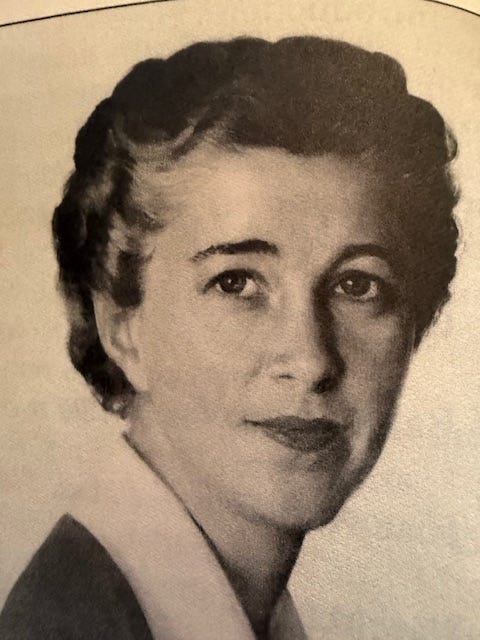Betty Crocker Cooking School of the Air
First put on the air in 1924, the Betty Crocker Cooking School of the Air was the first radio cooking show in the United States. From its onset, this cooking show had many features which were very different than Edouard de Pompiane’s cooking show which started a year earlier in France:
It was created by a leading producer of commercial flour - Washburn Crosby -which later became General Mills when it merged with four other flour companies in 1928. The founder of Washburn Crosby in 1856 was Cadwallader Washburn. He was a lawyer, three-time US Congressman; Governor of Wisconsin and served as a Union General during the Civil War. In 1878, he spent the equivalent of $3.7m (in today’s money) to build a new plant which could produce 5500 barrels of flour a day. At the time it would be the largest flour mill in the world and positioned Minneapolis as the flour milling capital of the world for fifty years.
“Gold Medal” flour evolved from Washington Crosby competing in the 1880 Miller’s International Exposition in Cincinnati for the best flour. The company won three medals including the top prize that they later named “Gold Medal”.
What defined the initiative was that Betty Crocker was actually a fictitious character (although this was an area of confusion by the public until even the 1940-1950’s. Marjorie Husted served as the Director for almost 2 decades and was actually introduced to visitors as Betty Crocker. About 5 marriage proposals a week were received by mail by the Company.)
The show debuted on a Minneapolis radio station purchased by Washburn Crosby and NBC subsequently picked up the show where it became one of the longest running radio shows in US history.
The name “Crocker” was borrowed from a much-loved retired Director of Washburn Crosby and Betty was an uncontroversial and acceptable middle-class first name.
The origin of the concept occurred in 1921 when Washburn Crosby placed an ad in the Saturday Evening Post which contained a puzzle of a downtown main street which contestants had to correctly complete in order to win a pin cushion in the form of a “Gold Medal” flour sack. The response from the public was overwhelming - 30,000 correct entries were received. As a result, a female chief of correspondence position was created to address the subsequent workload that evolved into both general and home economic questions from the readership. That the selected person should be a female was important for several reasons:
The Women’s Suffrage Act had just passed in 1920 after 42 years of Congressional consideration giving women the right to vote.
On average females spent 50% of disposable income in the typical household and 80% of food-related items.
It was felt that a “man” wouldn’t be respected as an expert on nutrition, cooking, health and related issues.
Within a few years, the company was receiving 4-5,000 letters a day. In comparison, the Roosevelt’s were receiving 7,000 letters daily during World War II.
In 1920, only 5,000 American families had radios. This soared to 2.5 million by 1924 and 6 million by 1927. On average, 1 million or more households regularly listened to the radio shows each week during its life span (1924-1954).
The first portrait of the fictitious Betty Crocker was painted by Nysen McMinn - one of the most renowned American illustrators of her era - in 1936. Many redo’s have been done over the years culminating in the last portrait being a blend of over 70 ethnicities.
Cookbooks with Betty Crocker recipes started appearing in the early 1930’s with the culmination being Betty Crocker’s Picture Cookbook. Released in 1950; 22 million copies have been sold in multiple editions.
In 1945 Fortune Magazine called Betty Crocker the 2nd most famous American woman after Eleanor Roosevelt.
Test kitchens were built and the general approach used for developing a recipe was a three-step process: first in the test kitchen; then to a Minneapolis audience and then finally on the Betty Crocker site.
BettyCrocker.com was launched in 1997 and received more than 12 million visitors a month.
The first product with the Betty Crocker name was dried soup mix. In the early 1920’s the company started inserting coupons in the flour sacks and a recipe box was made available upon request. The concept developed over the decade even further eg. by 1929, discount coupons were offered for Oneida silverware.
Between 1949 and 1964 the actress Adelaide Hardy played Betty Crocker on TV.
Commercial brands developed by General Foods starting in 1931 included Bisquick followed by cake, baking and other products. The Red Spoon premium label appeared subsequently.
Both the Depression and World War II were instrumental in furthering the popularity of the Betty Crocker brand due to its emphasis on nutrition, thrift and quality.
In summary, the corporate strategy to create and promote a fictitious character named Betty Crocker was brilliant and represents one of the greatest commercial marketing successes of the 20th Century. However, it remains to be seen whether it could be repeated today given the blurriness between direct marketing and on-line independence.
Next: Part 2: Exploring Betty Crocker’s recipes



